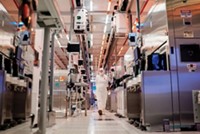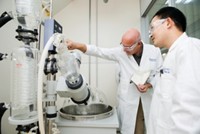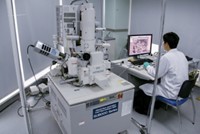Advertisement
Grab your lab coat. Let's get started
Welcome!
Welcome!
Create an account below to get 6 C&EN articles per month, receive newsletters and more - all free.
It seems this is your first time logging in online. Please enter the following information to continue.
As an ACS member you automatically get access to this site. All we need is few more details to create your reading experience.
Not you? Sign in with a different account.
Not you? Sign in with a different account.
ERROR 1
ERROR 1
ERROR 2
ERROR 2
ERROR 2
ERROR 2
ERROR 2
Password and Confirm password must match.
If you have an ACS member number, please enter it here so we can link this account to your membership. (optional)
ERROR 2
ACS values your privacy. By submitting your information, you are gaining access to C&EN and subscribing to our weekly newsletter. We use the information you provide to make your reading experience better, and we will never sell your data to third party members.
Business
Chinese Instrument Market Warms Up
Chinese instrument industry lags behind the world's but has tremendous room for growth
by Celia Henry Arnaud
April 3, 2006
| A version of this story appeared in
Volume 84, Issue 14
COVER STORY
Chinese Instrument Market Warms Up
From Pittcon
China makes up only a fraction of the global analytical instrumentation market, but its share of the market is poised to grow rapidly, according to speakers at a symposium at Pittcon.
Jia Wei, a sales representative for Bruker BioSpin in Beijing and Shanghai, gave an overview of the fast-growing Chinese instrumentation market, which has more than doubled in seven years, from $680 million in 1998 to $1.6 billion in 2005. Despite these gains, China accounts for less than 5% of the worldwide analytical market, which Wei estimated at $32.7 billion.
In China, imports comprise a large portion of the instrumentation market, amounting to $540 million in 2004, $236 million of which came from the U.S. American instrument exports to China quadrupled over a six-year period, from $60 million in 1998 to $236 million in 2004, making China the fifth-largest buyer of American instrumentation, Wei said.
Erkang Wang of the State Key Laboratory of Electroanalytical Chemistry at Changchun Institute of Applied Chemistry, said that only 30% of the analytical instruments in the Chinese market are made by Chinese companies, and those instruments tend to be of low value. Nearly 100% of the high-end instruments are imported, he said.
But China wants to reduce its dependence on imported instrumentation, Wei said. China also wants to produce high-quality analytical instruments that will be competitive in the world market. The goal is to increase instrumentation exports by more than 20% annually.
China has a long history of instrumentation innovation, going back more than 5,000 years, Wang said. In ancient times, astronomy was the key field, and the Chinese invented many instruments for tracking and simulating the movement of celestial bodies. The Chinese also invented early versions of compasses and seismographs.
Despite the invention of such instruments, the ancient Chinese bureaucracy stymied the overall development of science and technology, Wang said, because only those with literary talents ascended to the upper hierarchy, while those with scientific or technical skills were regarded as mere craftsmen. China still finds itself in the position of playing catch-up in the field of analytical instrumentation. The technology marketed by Chinese instrument companies typically lags three to eight years behind that sold by companies from other parts of the world, Wei said.
The need for Chinese instrumentation development is urgent, Wang said. Analytical technology will play a role in a number of areas. China faces the challenge of potential terrorist attacks as it prepares to host the 2008 Summer Olympics. Since China joined the World Trade Organization, the use of analytical methods to resolve conflicts in international trade has grown. On the domestic side, product safety and environmental protection are becoming increasingly important as the Chinese economy develops.
Nevertheless, the Chinese instrumentation industry must overcome a number of obstacles to its development, Wang said. Manufacturers don't have enough trained people or technical support for instrumentation research and development, he said. Most Chinese instrument manufacturers are small businesses that make low-value-added products, and product reliability remains an issue. These products are competitive only in terms of price, Wang said. He also complained that the areas of instrumentation development in academic institutes often do not match the needs of the commercial market.
As the Chinese economy progresses, the Chinese government is working to establish and enforce analytical standards, said Shaohong Jin, executive deputy director of the National Institute for the Control of Pharmaceutical & Biological Products, located in Beijing. With increasing domestic and international trade, certificates of analysis are required by a number of industries, especially the pharmaceutical industry. The value of imports and exports of the Chinese pharmaceutical industry continues to climb, Jin said.
Because of the increased demand for laboratory analyses, the China National Accreditation Board for Laboratories is implementing an accreditation system for testing and calibration labs according to international standards. So far, more than 10,000 labs have been accredited, Jin said, and that number is increasing. China is also revising and updating more than 10,000 standards for a number of analytical methods, he said.
The Chinese government has taken an active role in establishing laboratories for pharmaceutical analysis, according to Jin. Since 2003, the government has allocated $70 million for 400 "drug mobile laboratory vehicles" that are equipped for near-infrared spectroscopy, thin-layer chromatography, and microscopy to help root out substandard and counterfeit pharmaceutical products in rural China.
As these systems are put in place, the demand for analytical instruments in China continues to grow. In the drug-control area alone, demand will come from one national laboratory, 31 provincial or municipal institutes, and 333 district institutes. Each of these labs will require instruments, thereby providing tremendous opportunities for analytical instrument manufacturers, Jin said.
MORE ON THIS STORY
- Better Than Ever At Pittcon 2006
- Pittcon, Other Trade Shows May Be Declining In Importance For Small Firms
- Shimadzu Exhibits 50-Year-Old Gas Chromatograph At Pittcon
- Analyzing Vaccines
- Bioimaging With Mass Spectrometry
- Private Eye In The Lab
- Multitasking Cells
- Building Bridges
- Chinese Instrument Market Warms Up
- New & Notable At Pittcon 2006
Advertisement
All of the Pittcon speakers acknowledged that the Chinese instrument industry faces challenges, but they are optimistic about its bright prospects.








Join the conversation
Contact the reporter
Submit a Letter to the Editor for publication
Engage with us on Twitter